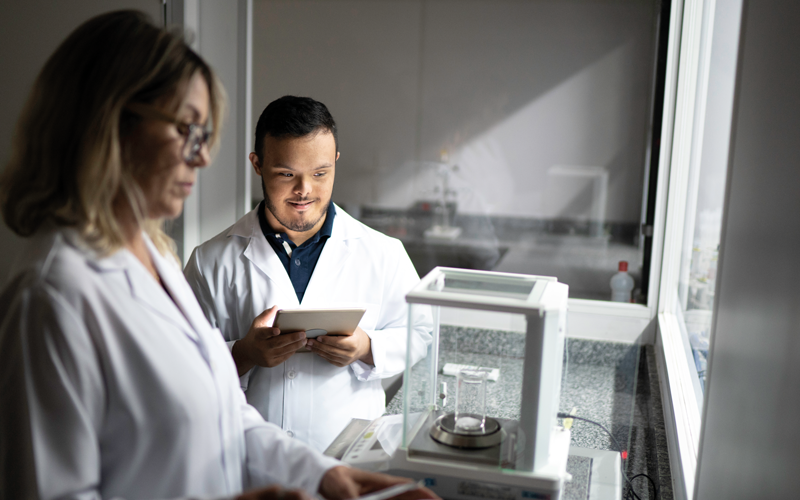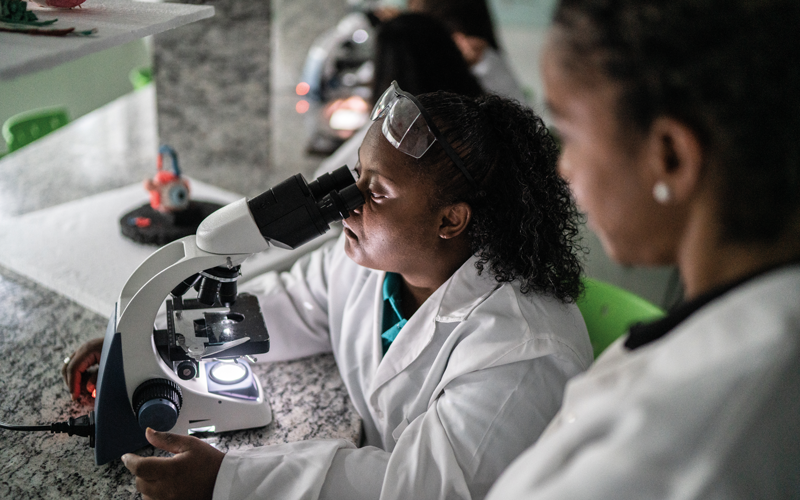To mark the International Day of Persons with Disabilities, Dr Laura Collins, Senior Lecturer in Biomedical Science at Queen’s University Belfast, reflects upon her personal experiences and shares some thoughts on supporting students with disabilities within the laboratory.

I’ve always had an interest in science, and I was ecstatic when I secured my place on a biomedical science degree. What I hadn’t really anticipated, however, was just how difficult it would be at times. I was born with oculocutaneous albinism – a genetic condition resulting in a lack of melanin and thus no pigment in my hair, skin or eyes. For me that meant poor vision, nystagmus (involuntary rapid eye movements) and photophobia (increased sensitivity to light). Funky hair aside, for the budding scientist in me, it meant lecture presentations that I could not follow, lab equipment that I could not locate or use, microscope images that lacked resolution and a growing sense of “I can’t do this”.
When I embarked upon my IBMS registration portfolio training, I quickly sensed that many in the profession felt that I couldn’t do it either. This hindered my training, dented my confidence and almost derailed my chances of obtaining the certificate of competence (I wanted to quit). As a disabled student, I knew that
I presented a challenge for training leads, particularly in a busy, non-inclusively designed (brand-new, might I add) clinical pathology lab where productivity and patient safety are paramount. Thanks to some incredible mentors, colleagues and friends within the profession, I did succeed. If I could do it all again, however, there are a few things that I would ask anyone involved with the training of disabled students to consider.
1. On day one of training, offer to meet the student at the main hospital entrance – somewhere easy to find. As a visually impaired student I found it hard to locate a pathology lab that’s hidden down the end of multiple hospital corridors, or in some derelict space at the back of the hospital grounds.
2. Offer to do this again on day two, three, four… until the student is confident that they can manage themselves, which won’t take long.
3. Offer the student an opportunity to visit the lab during a less busy period (weekend or during on-call times). As a visually impaired student it was difficult for me to orientate myself around the lab, and its much easier to do this when the space is quiet and there are very few people around.
4. Recognise that what you are describing might not match what the student is seeing or experiencing. I’d often find that trainers’ descriptions of microscope images wouldn’t match what my eyes were showing me. It’s not that I couldn’t pick out the difference between cell types or tissue structures, it’s just that my eyes’ interpretation of how they looked differed from my trainers’ eyes.
5. Recognise that the way you conduct a technique or experiment might not suit a student with a disability, but it doesn’t mean they can’t do it. For me, it was usually just a case of looking more closely at the object, but simple things like placing coloured card under agarose gel wells (to give contrast), switching out 30ml stripettes for 10ml (bigger graduations), holding a blood tube at eye level whilst pipetting (instead of in a rack, wearing goggles of course), buying a new ruler (instead of using the years-old faded wooden sticks), adjusting the lighting in the room (pulling the blinds) all made inaccessible tasks suddenly accessible.
6. Recognise that some students will need just a little bit more time and repetition than you are used to. When learning new techniques, I’d have to learn how to do it, figure out how I could adapt it, so that I could do it, and then learn that as well.

“Even if it was not the case, it could feel like every set of eyes was watching my every move”
7. Don’t assume that a mistake is due to the student having a physical or sensory disability. I could be equally inattentive, equally distracted, equally uninterested, and equally stupid. Not every mistake was due to my visual impairment – in fact, I don’t think any were.
8. Be open to reconsidering your assessment strategies. Think about why you are asking students to do things in a certain way. (e.g. Presenting at lab meetings – is it to foster presentation skills or to demonstrate knowledge? If it’s the latter, then a one-to-one conversation could be a much more accessible option for certain students.)
9. Be mindful that the student with the disability may be feeling self-conscious. Many of my personal adaptations involved looking very closely at things (almost touching my nose), holding equipment at funny angles and, even if it was not the case, it could feel like every set of eyes was watching my every move. Consider allowing the student to practise in quieter areas of the lab (where this can be accommodated).
10. Find the first thing that the student can do well and allow them to do it – every day, if necessary. I can still remember being entrusted with the HbA1c analyser in clinical chemistry and even though I struggled with other instruments and techniques this one responsibility made me feel useful and massively built my confidence until I mastered the other stuff.
11. Recognise that there may be one or two techniques that a student with a disability can never master (in your lab set-up), but that’s OK. It doesn’t mean that they can’t contribute massively to the work of the team. It doesn’t mean that they are incompetent, and it certainly doesn’t mean that they can’t go on to have a successful career as a biomedical scientist.
12. The next time you attend a new instrument demonstration, ask the reps to show you the accessibility settings. If they don’t have any, ask them why and remind them of equality legislation. Technology has advanced massively in the last few decades and chances are that your instrumentation has settings that you’re not even aware of.
13. You might know that a particular student will never be able to work as a biomedical scientist and will never be able to obtain HCPC registration. Believe me, they will know this too. This doesn’t mean that you shouldn’t train them to the best of your and their abilities. There are numerous careers out there in academia, research, medical communications, medical sales and patent law, among others. I personally decided not to work within NHS pathology labs partly because I knew that my visual impairment would significantly add to the stress of the job. However, I still love the subject and use my training every day, as I train the next generation of biomedical scientists in my role as a lecturer in this field.
Support is available if you have a disability or health condition that impacts upon your ability to find or stay in work. The UK government “Access to Work” scheme could provide a grant to pay for things such as:
- Specialist equipment and assistive software
- Physical adaptations to the workplace
- Travel expenses if you cannot use public transport
- Support workers
- Mental health support.
Reasonable adjustments are still the responsibility of the employer, however, Access to Work can provide advice for employers also. More information can be found at gov.uk/access-to-work
Image credit | iStock
